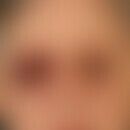Synonym(s)
HistoryThis section has been translated automatically.
Allen JN 1989
DefinitionThis section has been translated automatically.
Acute (idiopathic) eosinophilic pneumonia is an etiologically unexplained acute febrile illness associated with severe hypoxemia, bilateral extensive pulmonary infiltrates (predominantly milk glass opacity), and usually absent blood eosinophilia. The disease may be associated with hypereosinophilia syndrome (HES) (40% of HES patients have detectable eosinophilic pulmonary infiltrates).
You might also be interested in
Occurrence/EpidemiologyThis section has been translated automatically.
m:w=3:2
EtiopathogenesisThis section has been translated automatically.
Acute hypersensitivity reaction to an as yet unidentified inhalant allergen is assumed. Smoking is discussed as a triggering factor. Furthermore, various drugs and inhalation drug use are considered.
ManifestationThis section has been translated automatically.
Children and adults (5th decade of life)
ClinicThis section has been translated automatically.
Acute febrile illness of < 5 days' duration with cough, myalgias, pleuritic chest pain, and rapidly progressive respiratory failure.
The association of eosinophilic pneumonia with "eosinophilic anular erythema" has been described which should be interpreted as erythema anulare centrifugum (Yanagihara S et al. 2021).
DiagnosisThis section has been translated automatically.
Diagnosis is confirmed by BAL; detection of >25% eosinophilic granulocytes. Parasitic, mycotic (e.g. aspergillosis) or other infections associated with eosinophilia are excluded.
TherapyThis section has been translated automatically.
Rapid and complete therapeutic response to high-dose glucocorticoids. No recurrence after discontinuation of steroidal medication.
TablesThis section has been translated automatically.
Drugs associated with eosinophilic penumony (var. according to C. Kroegel 2000)
- Ampicillin
- Allopurinol
- Carbamazepine
- Clofibrate
- Cocaine (inhaled)
- Daptomycin
- Diclofenac
- Febuten
- Phenytoin
- Barbiturates
- Dapson
- GM-CSF
- Ibuprofen
- interleukin-2
- iodinated contrast media
- L-Tryptophan
- Methotrexate
- Minocycline
- Naproxen
- Nitrofurantoin
- Pentamidine (inhaled)
- Strontium ranelate (osteoporosis agent).
- Sulfonamides
- Tamoxifen
LiteratureThis section has been translated automatically.
- Ajani S et al.(2013) Idiopathic acute eosinophilic pneumonia: A retrospective case series and review of the literature. Respir Med Case Rep 10:43-47.
- GiovannFini-Chami L et al. (2016) Eosinophilic pneumonias in children: A review of the epidemiology, diagnosis, and treatment. Pediatr Pulmonol 51:203-216.
Hung SW (2015) Minocycline-induced acute eosinophilic pneumonia: A case report and review of the literature. Respir Med Case Rep 15:110-114.
- Janz DR et al (2009) Acute eosinophilic pneumonia: A case report and review of the literature. Crit Care Med 37:1470-1474.
- Kroegel C et al (2000) Eosinophilic pneumonia and eosinophilic gastroentritis. In: Przybilla B et al (eds) Practical allergological diagnostics. Steinkopff Verlag Darmstadt p.312.
- Lin SS et al. (2014) Crystal amphetamine smoking-induced acute eosinophilic pneumonia and diffuse alveolar damage: a case report and literature review. Chin J Physiol 57:295-298.
- Mullerpattan JB et al.(2013) Tropical pulmonary eosinophilia-a review. Indian J Med Res 138:295-302.
- Patel JJ et al (2014) Daptomycin-induced acute eosinophilic pneumonia. WMJ 113:199-201.
- Phillips J et al (2013) Daptomycin-induced acute eosinophilic pneumonia: analysis of the current data and illustrative case reports. Scand J Infect Dis 45:804-808.
- Yanagihara S et al (2021) Eosinophilic annular erythema associated with eosinophilic pneumonia and asthma. Int J Dermatol 60: 1034-1035.
Disclaimer
Please ask your physician for a reliable diagnosis. This website is only meant as a reference.




